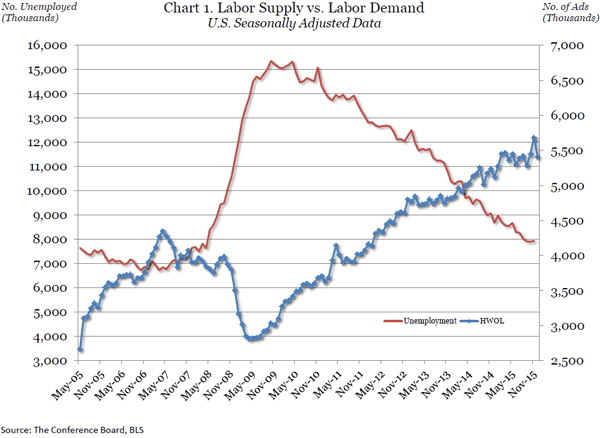- Home
- News
- Features
- Topics
- Labor
- Management
- Opinions/Blogs
- Tools & Resources
Labor Demand Weak, Online Help Wanted Ads Down 158,000 In March
Online Labor Demand drops 158,000 in March
-
Labor demand down 77,000 in Q1 of 2013
-
Q1’13 decline follows three years of strong Q1 growth since the end of the recession
-
March is mixed with drops in Healthcare, Sales, and Office workers outstripping increases in Management, Business, and Computer workers
Download the National Historical Table.
Online advertised job vacancies dropped 158,000 in March to 4,898,700 in The Conference Board Help Wanted OnLine (HWOL) Data Series.
 The March drop follows a small dip in February (44,400); the two combined offset the January gain. The Supply/Demand rate stands at 2.4 unemployed for every vacancy.
The March drop follows a small dip in February (44,400); the two combined offset the January gain. The Supply/Demand rate stands at 2.4 unemployed for every vacancy.
In February, there were 7 million more unemployed than the number of advertised vacancies, down from 11.9 million at the end of the recession in June 2009.
“Labor demand has been up and down for the last six months, leaving the new March level basically the same as it was in September 2012,” said June Shelp, VP at The Conference Board.
Sequestration, along with the indecision in Washington, has most likely taken its toll with employers in many industries hesitating to aggressively look for new workers.
The unevenness in labor demand continues with unemployed workers in healthcare professions and business professions like computers, business, and finance finding ample job opportunities.
Competition is stiffer with anywhere from 2 to 4 unemployed for every available opening in many lower-paying occupations (sales workers, office workers, food workers, transportation workers) (Table 7, page 14).
REGIONAL AND STATE HIGHLIGHTS
-
All 4 regions declined in March
-
19 of the 20 largest States (all but PA) declined
March Changes for States
 In March, online labor demand dipped in 46 of the 50 States in the U.S. (Table 3). Nevada remained constant, and Pennsylvania, Oregon, and Montana increased. About 75 % (37 of the 50 States) are above last year’s March levels.
In March, online labor demand dipped in 46 of the 50 States in the U.S. (Table 3). Nevada remained constant, and Pennsylvania, Oregon, and Montana increased. About 75 % (37 of the 50 States) are above last year’s March levels.
Online labor demand in the South dropped 66,400 in March (Table A) with Florida, among the large states, experiencing the largest decline (-15,200).
Other large States with declines included Texas, down 9,600; Virginia, down 7,900; Georgia, down 7,500; Maryland, down 5,800; and North Carolina, down 2,300. Among the smaller States, Tennessee lost 4,400, South Carolina decreased by 3,800, Arkansas declined 1,000, and Louisiana dropped 900.
Employment vs. Labor Demand[/caption]
In the Midwest online labor demand fell 41,200 in March. Illinois and Ohio were down 11,300 and 9,600 respectively while Missouri fell 5,700.
Other large States with March declines included Minnesota, which was down 4,400, Michigan, which decreased by 2,900, and Wisconsin, which lost 1,900.
Among the smaller Midwest States in March, Indiana fell 4,800, Kansas dropped 3,400, and North Dakota lost 1,800.
Online labor demand in the West decreased by 16,000 in March.
Washington led the decline with a decrease of 8,800. Arizona dropped 4,500, California decreased 2,100, and Colorado declined by 1,200. Among the smaller States in March, Oregon gained 1,200 while Nevada remained constant and Utah fell 1,100 (Table 3).
Online labor demand in the Northeast dipped 6,500 in March with Pennsylvania up 2,100 to 203,700, its series high. Pennsylvania was the only large State posting an increase.
Other large states with lower labor demand included Massachusetts, down 3,300; New Jersey, down 2,300; and New York, down 300. Among the smaller States in the Northeast, March labor demand decreased by 900 in Rhode Island, 800 in Connecticut, 800 in New Hampshire, and 200 in Maine (Table 3).
The Supply/Demand rates for the States are for February 2013, the latest month available for state unemployment data. The number of advertised vacancies exceeded the number of unemployed only in North Dakota, where the Supply/Demand rate was 0.61.
The state with the highest Supply/Demand rate is Mississippi (5.26), where there were over five unemployed workers for every online advertised vacancy
Note that the Supply/Demand rate only provides a measure of relative tightness of the individual State labor markets and does not suggest that the occupations of the unemployed directly align with the occupations of the advertised vacancies.
METRO AREA HIGHLIGHTS
-
In March, 41 of the 52 largest metro areas posted decreases in labor demand while 11 posted increases
-
Almost half of the largest metro areas (24) have supply/demand rates below 2, indicating that there are fewer than two unemployed workers for every online advertised vacancy
Metro Area Changes
In March, 13 of the 20 largest MSAs and 41 of the 52 metropolitan areas for which data are reported separately posted decreases in the number of advertised vacancies (Table B and Table 5).
Metro areas with March gains were located across the U.S. with a large number in the West including San Francisco, up 3,400; San Jose, up 900; Denver, up 400; and San Diego, up 100.
In the other regions, the New York metro area in the Northeast posted a gain of 3,500 advertised vacancies; Dallas in the South, rose 300; and Detroit in the Midwest, was up 200. (Table B).
Twenty-four of the MSAs reported separately had Supply/Demand rates in January 2013 (the latest available data for unemployment) lower than 2, indicating there are fewer than two unemployed for every advertised vacancy (See Table 6).
Washington, DC continues to have the most favorable Supply/Demand rate (1.05) with about one advertised vacancy for every unemployed worker.
Minneapolis-St. Paul (1.16), Oklahoma City (1.17), Salt Lake City (1.24), Boston (1.33), San Jose (1.38), Seattle-Tacoma (1.39), Austin (1.43), and Columbus (1.43) had the next lowest Supply/Demand rates.
Metro areas in which the number of unemployed is substantially above the number of online advertised vacancies include Riverside, Calif., with nearly seven unemployed workers for every advertised vacancy (6.65); Las Vegas (3.69); Sacramento (3.55); and Los Angeles (3.47). (See Table 6)
Since the end of the recession in June 2009, a number of the large metro areas have posted gains in labor demand above 100%.
The most notable of these are Charlotte (up 148%), Cleveland (up 143%), Columbus (up 140%), Denver (up 139%), Detroit (up 137%), Minneapolis-St. Paul (up 136%), Nashville (up 134%), Portland (up 132%), Milwaukee (up 125%), and Birmingham (up 119%).
OCCUPATIONAL HIGHLIGHTS
-
6 of the 22 major groups in the Standard Occupational Classifications (SOC) rose in March
-
16 of the 22 major SOC groups declined (Table C and Table 7)
-
March declines included Healthcare, Sales and Office workers
-
Declines outstripped gains in Management, Business and Computer workers
Occupational Changes for the Month of March
In March, among the largest occupational groups, Healthcare Practitioners and Technical occupations fell 25,800 to 563,200, led by a decrease in demand for Registered Nurses, Pharmacy Technicians, and General Internists.
Sales and Related occupations dropped 24,800 to 577,900, driven by decreased demand for First-Line Supervisors / Managers of Retail Sales Workers, Financial Services Sales Agents, Demonstrators and Product Promoters, and Telemarketers.
Office and Administrative Support occupations fell 24,600 to 525,600, largely due to lower demand for First-Line Supervisors / Managers of Office and Administrative Support Workers, Receptionists and Information Clerks, Medical Secretaries, and General Office Clerks.
On the positive side were Computer and Mathematical Science occupations, up 8,300 to 619,100, led by an increase in demand for Applications Software Developers and Computer Systems Analysts.
Business and Financial Operations occupations rose 4,200 to 310,100 due to higher demand for Market Research Analysts and Marketing Specialists, Accountants, Financial Analysts, and Employment, Recruitment, and Placement Specialists (Table C).
PROGRAM NOTES
HWOL 2013 Annual Revisions
The HWOL program incorporated its annual revision with the February release, which ensures the accuracy and consistency of the time series.
This year’s annual revisions include the introduction of the 2010 SOC occupational codes, several updates to the HWOL unduplication methodology, and the annual update of seasonal adjustment factors.
To insure the consistency of the HWOL time series, data for the full time series from May 2005 to the present have been recalculated using the new standards. The annual revision has left most levels and trends relatively consistent with the prior series.
Please subscribe to WWOW’s posts by email:
[subscribe2]
List your business in the premium web directory for free This website is listed under Human Resources Directory




